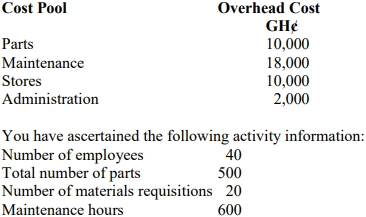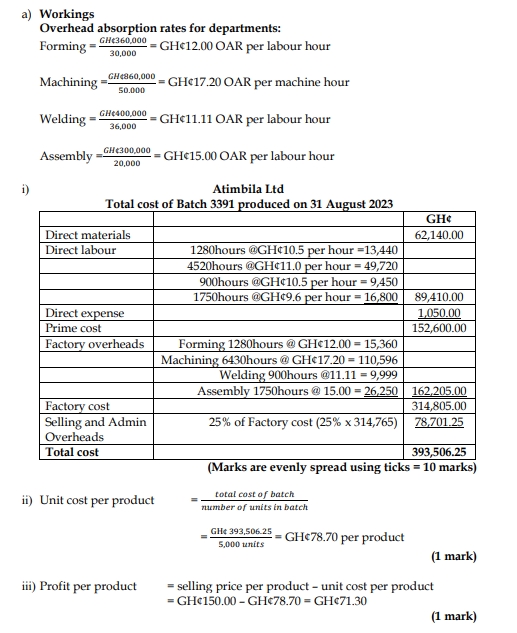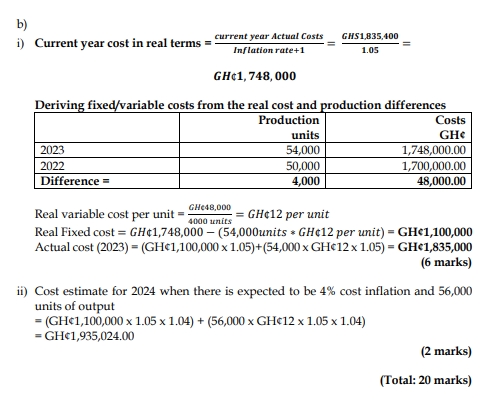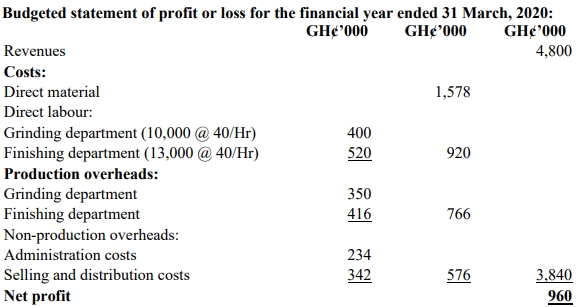- 15 Marks
Question
The details of unit cost of products X, Y, and Z have been provided below:
| Product | X | Y | Z |
|---|---|---|---|
| Demand (units) | 1,200 | 2,800 | 3,000 |
| GH¢ | GH¢ | GH¢ | GH¢ |
| Direct Material | 70 | 55 | 40 |
| Direct Labour | 65 | 60 | 38 |
| Variable Overheads | 11 | 8 | 7 |
| Fixed Overhead | 32 | 24 | 20 |
Additional information:
- The fixed overheads were absorbed at the rate of GH¢8 per machine hour.
- The budgeted fixed overheads of GH¢165,600 can be analysed into the following cost pools with their respective percentages for apportionment:
Cost Pool Percentages (%) Batch 20 Machinery 45 Customer service 25 Deliveries 10 - The following also relates to the activities of the company:
| Product | X | Y | Z |
|---|---|---|---|
| Units in a batch | 120 | 140 | 200 |
| Quantities per delivery | 100 | 280 | 250 |
| Number of customers | 50 | 180 | 220 |
Required:
i) Calculate the activity rates per batch, machine hour, customer service, and delivery.
(12 marks)
ii) Calculate the total cost of a unit of product X.
(3 marks)
Answer
a) Workings:
Apportionment of Overheads (GH¢165,600):
| Cost Pool | Percentage (%) | Overhead (GH¢) |
|---|---|---|
| Batch | 20 | 33,120 |
| Machinery | 45 | 74,520 |
| Customer Service | 25 | 41,400 |
| Deliveries | 10 | 16,560 |
Machine hours:
- X = 1,200 units × 4 hours = 4,800
- Y = 2,800 units × 3 hours = 8,400
- Z = 3,000 units × 2.5 hours = 7,500
Total = 20,700
Number of batches:
- X = 1,200 ÷ 120 = 10
- Y = 2,800 ÷ 140 = 20
- Z = 3,000 ÷ 200 = 15
Total = 45
Number of deliveries:
- X = 1,200 ÷ 100 = 12
- Y = 2,800 ÷ 280 = 10
- Z = 3,000 ÷ 250 = 12
Total = 34
Number of customers:
- Total = 450
Statement showing calculation of activity rates:
| Activity Base | Overhead (GH¢) | Number of Activities | Rate (GH¢) |
|---|---|---|---|
| Machine related | 74,520 | 20,700 hours | 3.6 per hour |
| Batch related | 33,120 | 45 batches | 736 per batch |
| Delivery related | 16,560 | 34 deliveries | 487 per delivery |
| Customer Service | 41,400 | 450 customers | 92 per customer |
(12 marks)
ii) Cost per unit of Product X (1,200 units):
| Description | GH¢ |
|---|---|
| Prime cost GH¢146 × 1,200 | 175,200 |
| Overheads: | |
| Machine-related (4,800 × 3.6) | 17,280 |
| Batch-related (10 × 736) | 7,360 |
| Delivery-related (12 × 487) | 5,844 |
| Customer service (50 × 92) | 4,600 |
| Total | 210,284 |
Cost per unit = 210,284 ÷ 1,200 = GH¢175.24
(3 marks)
- Topic: Activity-based costing
- Series: AUG 2022
- Uploader: Joseph





